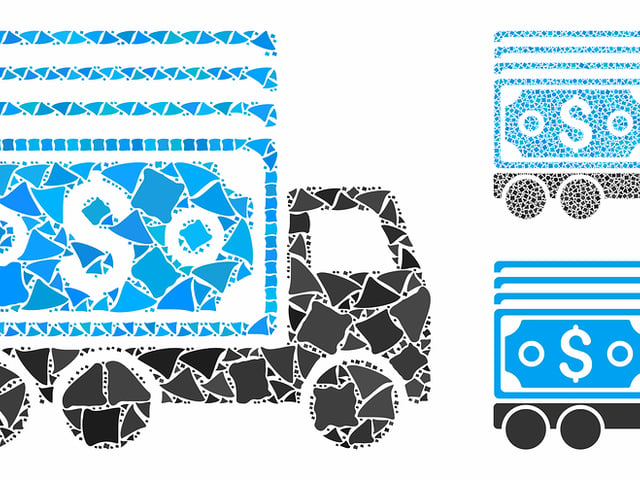
How Much Does It Cost to Get a CDL?
There are entry costs for getting a Commercial Driver’s License (CDL)—costs in both money and time.
You can start this profitable career in two or three months with $3,000. If you don’t have $3,000 available, there are several possible options. Read the Financing Options section, below.
Monetary Costs
The total cost to acquire a CDL is about $3,000. The school will be about $2,000 to $2,500. The rest of the cost covers the medical exam, DMV fees, and testing fees. If driving schools give you numbers that are much higher than these, keep looking.
To perform certain types of truck driving, you’ll need to add “endorsements” to your CDL license, which cover skills like tanker truck driving and transporting hazardous materials. In theory, you could pay less if you don’t get any endorsements on your license. This is a bad idea. Getting everything taken care of with one or two trips to the DMV is much better than going back time and time again. Plus, any potential employer wants to hire someone that has all the required endorsements. If a company has a specific need, it doesn’t want to wait for you to go back to the DMV and add an endorsement.
These costs will be higher in some places because it is expensive to do business in some states, so those states will have higher tuition costs. Some of these differences fluctuate with time. For example, Texas is experiencing a boom. Prices are higher there. Currently, CDL school in Texas is between $4,000 and $4,500. This is for the school only. Expect to add another $500 for DMV fees, medical exam, etc. Of course, the job prospects are much better in Texas—because Texas is experiencing a boom.
A word of caution: don’t fall for the “prestige” line. Some schools are better than others, but not thousands-of-dollars better.
If you don’t have $3,000 cash, keep reading.
Financing Options
Loans
I discourage people from borrowing money if it can be avoided. Debt can be a terrible burden. However, sometimes debt is the only way to get into a driving program.
Most schools work with affiliate-lending organizations. These affiliates are third-party lenders that will lend a student the $3,000 it takes to get their CDL. The school’s admission clerk will help you with the paperwork and the school will handle the money. After you graduate, you pay the loan back, with interest.
Why do you need to think before borrowing? This is a loan. You will have to pay it back, with interest. Also, if you don’t get your CDL, you still have to pay the money back. Just be sure you understand these things before signing on the dotted line.
Paying Off Loans
It is important to get your loans paid off. Debt and interest is a burden that will sap the money right out of your life.
Important, basic principles of personal finance:
- Spend less than you make.
- Save and invest the excess.
- Budget.
- Don’t bounce checks.
- Stay out of debt.
- Be responsible with your money.
- Don’t make spontaneous decisions about large sums of money.
If you have a good plan, you can retire with dignity.
Tuition Reimbursement
Many entry-level driving companies offer tuition reimbursement. After working a starter job for six months, they will pay off your loan to the third-party lender—usually, a flat rate of $2,500. The driving company will put conditions on tuition reimbursement. Normal conditions might be:
- Accident-free for six months
- No service failures
- No missed JIT (Just In Time) deliveries
- Fewer than three safety violation “points”
- Fewer than three HOS (Hours Of Service) errors
- Successfully finishing eight weeks of company training
Most companies don’t start counting your six months until after you finish the eight weeks of in-house training. So, it is actually eight months.
It isn’t an ideal situation, but most drivers’ first job will be at a starter job anyway—you might as well take advantage of the free money.
Time Considerations
You will need to plan for three uninterrupted months. School is five weeks. Technically, the entire process (student to job) takes six to eight weeks, but you need to be prepared to wait for the right job to roll around because things go exactly as planned.
Learning Time
Classes will probably be all day Monday through Friday but you will have at least one night-driving class. Expect to spend one day at home each weekend, studying and getting ready for tests.
The standard program is 160 hours. Almost all entry-level driving companies will want to see a certificate for 160 hours for insurance reasons. (There is a current minimum requirement of 160 hours. That number could change in the future.)
There is a tiny number of schools that charge half as much money—and help you get a CDL in fewer than 160 hours (sometimes as little as one/two weeks.) If you don’t get your 160-hour certificate, make certain that the driving company will actually hire you. Essentially, you will need to be hired before you go to school. From a practical point of view, the only way I can see this working is if you were already an employed equipment operator (oil field, construction, carnival, etc.) and you wanted a CDL so you could transport the equipment. Be very careful. You could spend money and time and end up with a license that won’t get you a job.
When you graduate, you’ll want to start working right away. The lessons will be fresh in your mind. You don’t want to wait several months before you take the driving test for a new job. You might forget how to shift a 10-speed.
Time to Secure a Job
Regarding waiting for a job, there are always companies scrambling for drivers, but not always the specific company that you want. Here are a couple of personal examples:
When I graduated, I had three offers. Because my brother worked for one of the better companies, I was able to get a driving job that paid a higher per-mile rate.
A friend in my class had a job offer from his neighbor, who owned a steel hauling business. When my friend graduated, the steel hauling company didn’t have an open contract. My friend had to wait two months for the contract to start. (Fortunately, he was retired–so he could wait for the specific job he wanted.) This was moderately risky—he passed on several driving jobs while waiting for the right job to open up.
Other Considerations
There are other things to think about, such as housing if the school is not near your home. How much do you want the job? I know more than one driver who lived in a tent in a campground for five weeks to get through drivers’ school. In their cases, they (and all their family and friends) lived far from the nearest truck driving school.
Exciting New Life
Yes, there are investments of time and money involved, but you are starting an adventure. Being a professional driver is one of the most profitable careers in which you can get involved.
Unless you have a friend or relative who will hire you directly out of school, you will begin your driving career at a starter job. One year after starting driving school, you could be making $4,500–$5,000 per month.
Driving will not be dull. Sometimes driving will be awful, but it will never be boring. Trucking companies are always scrambling for drivers, so if you are dependable, careful, and don’t wreck the truck, you will always be able to find work. And, you can make so much money.
Keep Reading

Commercial Driver's License Test Blog
How Many Questions are on the CDL Permit Test?
Embarking on a career in commercial truck driving begins with a crucial…

Commercial Driver's License Test Blog
What are the Three Tests for the CDL Permit?
If you’re looking to embark on a career in truck driving, obtaining a C…

Commercial Driver's License Test Blog
How Much Does It Cost to Get a CDL?
The trucking industry dominates freight shipping. Trucks handle over 70…